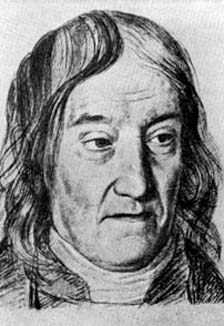<Back to Index>
- Mathematician Farkas Bolyai, 1775
- Architect Jacobus Johannes Pieter Oud, 1890
- Senator Pietro Sandro Nenni, 1891

Farkas Bolyai (February 9, 1775 - November 20, 1856, also known as Wolfgang Bolyai in Germany) was a Hungarian mathematician, mainly known for his work in geometry.
Bolyai was born in Bolya (Buia), a town near Nagyszeben (today Sibiu) in Transylvania. Farkas was taught at home by his father until the age of six years when he was sent to the Calvinist school in Nagyszeben. His teachers recognised his talents in arithmetic and in learning languages. When he became 12 years old he left school and was appointed as a tutor to the eight year old son of the count Kemény. This meant that Bolyai was now treated as a member of one of the leading families in the country, and he became not only a tutor but a real friend to the count's son. In 1790 Bolyai and his pupil both entered the Calvinist College in Kolozsvár (Cluj-Napoca) where they spent five years. The professor of philosophy at the College in Kolozsvár tried to turn Bolyai against mathematics and towards religious philosophy. Bolyai, however, decided to go abroad with Simon Kemény on an educational trip in 1796 and began to study mathematics systematically at German universities first in Jena and then in Göttingen. During this period Bolyai became a close friend of Carl Friedrich Gauss.
He returned home to Kolozsvár in 1799. It was there he met and married Zsuzsanna Benkö and where their son János Bolyai -
later an even more famous mathematician than his father - was born in
1802. Soon thereafter he accepted a teaching position in mathematics
and sciences at the Calvinist College in Marosvásárhely (Târgu-Mureş), where he spent the rest of his life. Bolyai's main interests were the foundations of geometry and the parallel axiom. His main work, the Tentamen (Tentamen iuventutem studiosam in elementa matheosos introducendi), was an attempt at a rigorous and systematic foundation of geometry, arithmetic, algebra and analysis. In this work, he gave iterative procedures
to solve equations which he then proved convergent by showing them to
be monotonically increasing and bounded above. His study of the convergence of series includes a test equivalent to Raabe's test, which he discovered independently and at about the same time as Raabe. Other important ideas in the work include a general definition of a function and a definition of an equality between two plane figures if they can both be divided into a finite equal number of pairwise congruent pieces. He first dissuaded his son from the study of non-Euclidean geometry, but by 1830 he became enthusiastic enough to persuade his son to publish his ground-breaking ideas.